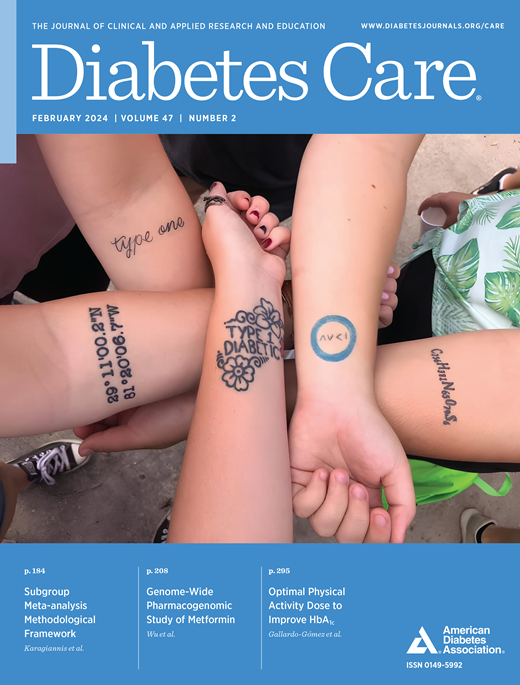糖尿病上肢并发症:叙述性回顾
IF 16.6
1区 医学
Q1 ENDOCRINOLOGY & METABOLISM
引用次数: 0
摘要
糖尿病上肢并发症(ULCs)影响关节、肌腱、肌肉、结缔组织、神经和皮肤,是1型和2型糖尿病中未被充分认识但普遍存在的疾病。糖尿病护理的进步延长了预期寿命,导致糖尿病患者老龄化,除了传统的血管问题外,对长期并发症的易感性增加。尽管有一些关于ULCs流行病学的数据,但对其发病机制、预防和对生活质量的影响的了解仍然有限,治疗往往基于临床经验,而不是强有力的证据。ULCs,包括肩周炎、扳机指、腕管综合征、尺神经压迫、伴有挛缩的Dupuytren病和关节活动受限,在糖尿病患者中发生的频率是糖尿病患者的2 - 3倍,在50岁以上和糖尿病病程较长的人群中发病率更高。慢性高血糖、胶原糖基化和低度炎症是推测的致病因素。可改变的危险因素包括血糖控制不良、吸烟和肥胖。糖尿病患者的症状缓解较慢,复发率较高,双侧或多重疾病的可能性较大。临床医生和患者的意识至关重要,重点是常规筛查和主动管理。早期诊断、患者教育和有针对性的干预可以减轻长期并发症,提高生活质量。未来的指南应将ULC监测纳入常规糖尿病护理,并优先进行临床试验,以建立循证管理策略。全面解决ULCs问题将提高糖尿病患者的预后,确保更好的功能健康和减轻社会负担。本文章由计算机程序翻译,如有差异,请以英文原文为准。
Upper-Limb Complications in Diabetes: A Narrative Review
Upper-limb complications (ULCs) in diabetes, affecting joints, tendons, muscles, connective tissue, nerves, and skin, are underrecognized but prevalent conditions in type 1 and type 2 diabetes. Advances in diabetes care have extended life expectancy, leading to an aging population with diabetes with increased susceptibility to long-term complications beyond traditional vascular issues. Despite some data on ULCs epidemiology, understanding of their pathogenesis, prevention, and impact on quality of life remains limited, and treatments are often based on clinical experience rather than robust evidence. ULCs, including frozen shoulder, trigger finger, carpal tunnel syndrome, ulnar nerve entrapment, Dupuytren disease with contracture, and limited joint mobility, occur two to three times more frequently in diabetes, with higher rates in individuals aged>50 years and those with longer diabetes duration. Chronic hyperglycemia, glycation of collagen, and low-grade inflammation are hypothesized contributors. Modifiable risk factors include poor glycemic control, smoking, and obesity. Individuals with diabetes face slower symptom resolution, higher recurrence rates, and a greater likelihood of bilateral or multiple conditions. Awareness among clinicians and patients is critical, with emphasis on routine screening and proactive management. Early diagnosis, patient education, and targeted interventions can mitigate long-term complications and improve quality of life. Future guidelines should integrate ULC monitoring into routine diabetes care and prioritize clinical trials to establish evidence-based management strategies. Addressing ULCs comprehensively will enhance outcomes for individuals with diabetes, ensuring better functional health and reduced societal burden.
求助全文
通过发布文献求助,成功后即可免费获取论文全文。
去求助
来源期刊

Diabetes Care
医学-内分泌学与代谢
CiteScore
27.80
自引率
4.90%
发文量
449
审稿时长
1 months
期刊介绍:
The journal's overarching mission can be captured by the simple word "Care," reflecting its commitment to enhancing patient well-being. Diabetes Care aims to support better patient care by addressing the comprehensive needs of healthcare professionals dedicated to managing diabetes.
Diabetes Care serves as a valuable resource for healthcare practitioners, aiming to advance knowledge, foster research, and improve diabetes management. The journal publishes original research across various categories, including Clinical Care, Education, Nutrition, Psychosocial Research, Epidemiology, Health Services Research, Emerging Treatments and Technologies, Pathophysiology, Complications, and Cardiovascular and Metabolic Risk. Additionally, Diabetes Care features ADA statements, consensus reports, review articles, letters to the editor, and health/medical news, appealing to a diverse audience of physicians, researchers, psychologists, educators, and other healthcare professionals.
 求助内容:
求助内容: 应助结果提醒方式:
应助结果提醒方式:


